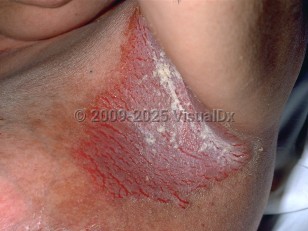Hailey-Hailey disease
See also in: AnogenitalAlerts and Notices
Important News & Links
Synopsis

Hailey-Hailey disease, also known as benign familial pemphigus, is an uncommon autosomal dominant disease with complete penetrance but variable expression. It primarily affects intertriginous skin, mostly the axillae, groin, lateral neck, and perianal region. The posterior neck, inframammary area, antecubital fossae, and popliteal fossae may be involved less frequently, as may nonintertriginous skin. There is no sex predilection, and onset tends to be in the late-second-to-third decade of life, although it has been reported in younger and middle-aged patients.
Hailey-Hailey disease begins as tiny, flaccid vesicles that may coalesce into bullae on normal or erythematous skin. The fragile bullae tend to rupture, leaving moist erosions and crusts. Vegetative, eroded plaques may form in established lesions. The eroded plaques tend to spread peripherally with central clearing, resulting in a circinate and/or serpiginous morphology. Microbial colonization and infection are common and may render malodorous lesions. Segmental involvement along the lines of Blaschko due to mosaicism has been reported. Pruritus and pain may be associated with the lesions, especially in high-friction areas.
Hailey-Hailey disease is caused by mutations in the ATP2C1 gene on chromosome 3. This gene encodes a Ca2+/Mn2+ ATPase protein. The abnormal protein alters calcium signaling and thereby leads to acantholysis.
The course is chronic, but severity tends to wax and wane. Heat, humidity, friction, and ultraviolet (UV) exposure are known to exacerbate this disease.
Hailey-Hailey disease begins as tiny, flaccid vesicles that may coalesce into bullae on normal or erythematous skin. The fragile bullae tend to rupture, leaving moist erosions and crusts. Vegetative, eroded plaques may form in established lesions. The eroded plaques tend to spread peripherally with central clearing, resulting in a circinate and/or serpiginous morphology. Microbial colonization and infection are common and may render malodorous lesions. Segmental involvement along the lines of Blaschko due to mosaicism has been reported. Pruritus and pain may be associated with the lesions, especially in high-friction areas.
Hailey-Hailey disease is caused by mutations in the ATP2C1 gene on chromosome 3. This gene encodes a Ca2+/Mn2+ ATPase protein. The abnormal protein alters calcium signaling and thereby leads to acantholysis.
The course is chronic, but severity tends to wax and wane. Heat, humidity, friction, and ultraviolet (UV) exposure are known to exacerbate this disease.
Codes
ICD10CM:
Q82.8 – Other specified congenital malformations of skin
SNOMEDCT:
79468000 – Familial benign pemphigus
Q82.8 – Other specified congenital malformations of skin
SNOMEDCT:
79468000 – Familial benign pemphigus
Look For
Subscription Required
Diagnostic Pearls
Subscription Required
Differential Diagnosis & Pitfalls

To perform a comparison, select diagnoses from the classic differential
Subscription Required
Best Tests
Subscription Required
Management Pearls
Subscription Required
Therapy
Subscription Required
References
Subscription Required
Last Reviewed:09/09/2023
Last Updated:09/10/2023
Last Updated:09/10/2023
Hailey-Hailey disease
See also in: Anogenital
